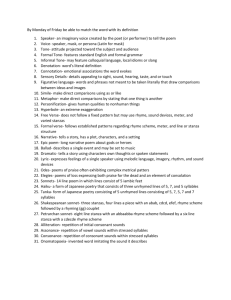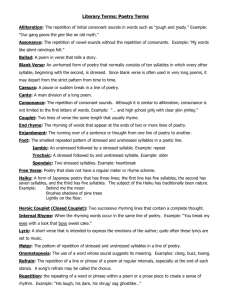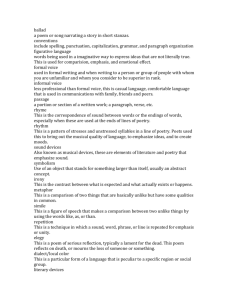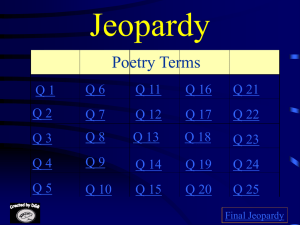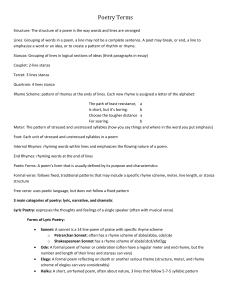The Language of Poetry
advertisement
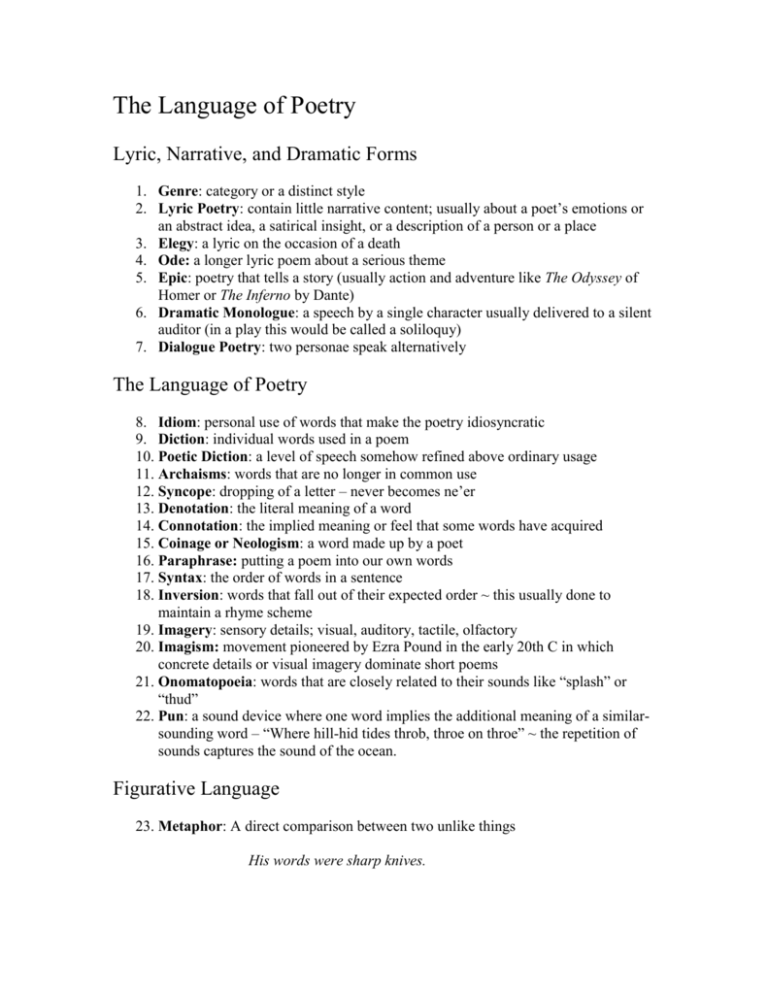
The Language of Poetry Lyric, Narrative, and Dramatic Forms 1. Genre: category or a distinct style 2. Lyric Poetry: contain little narrative content; usually about a poet’s emotions or an abstract idea, a satirical insight, or a description of a person or a place 3. Elegy: a lyric on the occasion of a death 4. Ode: a longer lyric poem about a serious theme 5. Epic: poetry that tells a story (usually action and adventure like The Odyssey of Homer or The Inferno by Dante) 6. Dramatic Monologue: a speech by a single character usually delivered to a silent auditor (in a play this would be called a soliloquy) 7. Dialogue Poetry: two personae speak alternatively The Language of Poetry 8. Idiom: personal use of words that make the poetry idiosyncratic 9. Diction: individual words used in a poem 10. Poetic Diction: a level of speech somehow refined above ordinary usage 11. Archaisms: words that are no longer in common use 12. Syncope: dropping of a letter – never becomes ne’er 13. Denotation: the literal meaning of a word 14. Connotation: the implied meaning or feel that some words have acquired 15. Coinage or Neologism: a word made up by a poet 16. Paraphrase: putting a poem into our own words 17. Syntax: the order of words in a sentence 18. Inversion: words that fall out of their expected order ~ this usually done to maintain a rhyme scheme 19. Imagery: sensory details; visual, auditory, tactile, olfactory 20. Imagism: movement pioneered by Ezra Pound in the early 20th C in which concrete details or visual imagery dominate short poems 21. Onomatopoeia: words that are closely related to their sounds like “splash” or “thud” 22. Pun: a sound device where one word implies the additional meaning of a similarsounding word – “Where hill-hid tides throb, throe on throe” ~ the repetition of sounds captures the sound of the ocean. Figurative Language 23. Metaphor: A direct comparison between two unlike things His words were sharp knives. 24. Simile: a comparison using like or as, or than as a connecting device “My love is like a red, red rose…” Robert Burns 25. Conceit: an extended far-fetched metaphor, in most cases comparing things that apparently have nothing in common “Make me, O Lord, thy spinning wheel complete…” Edward Taylor (“Huswifery” draws an analogy between the process of salvation and the manufacture of clothing ~ the loom becomes a cross) 26. Hyperbole: overstatement, a comparison using conscious exaggeration He threw the ball so fast it caught the catcher’s mitt on fire. 27. Understatement: the opposite of hyperbole “I don’t think we’re in Kansas anymore, Toto.” (Dorothy, The Wizard of Oz) 28. Allusion: metaphor making a direct comparison to a historical or literary event or character, a myth, biblical reference, etc. He is a Samson of strength but a Judas of duplicity. 29. Personification: giving human characteristics to nonhuman things or abstractions The ocean cursed and spat at us. 30. Apostrophe: variety of personification in which a nonhuman thing, abstraction, or person not physically present is directly addressed as it if could respond “Milton! Thou should be living at this hour.” William Wordsworth 31. Paradox: an apparent contradiction or illogical statement I’ll never forget old what’s-his-name. 32. Oxymoron: a short paradox, usually consisting of an adjective and noun with conflicting meanings The touch of her lips was sweet agony. 33. Synesthesia: a conscious mixing of two different types of sensory experience A raw, red wind rushed from the north. Allegory and Symbol 34. Allegory: usually a narrative that exists simultaneously on at least two levels, a literal level and a second level of abstract meaning; prose examples of an allegory are the fable (a short, nonrealistic narrative told to illustrate a universal moral concept) and the parable (similar to a fable, but it contains realistic elements to convey a universal moral concept) 35. Symbol: any concrete thing or action in a poem that implies a meaning beyond its literal sense 36. Traditional Symbols: examples are colors, flowers, natural objects or religious symbols 37. Private Symbol: something that acquires a meaning from a single poet’s repeated use 38. Incidental Symbol: things that are not usually considered symbolic, but may be in a particular poem Tone of Voice 39. Tone: the speaker’s implied attitude toward the words he or she says, depends primarily on vocal inflection 40. Irony: a poet may imply an attitude that is contrary to what his words appear to say 41. Sarcasm: the wounding tone of voice we use to imply the exact opposite of what we say 42. Verbal Irony: the conscious manipulation of tone by the poet that reveals an attitude opposite to what he or she says 43. Epigram: a short satirical piece 44. Situational Irony: the setting of the poem presents a built-in incongruity 45. Dramatic Irony: the persona of the poem is less aware than the reader of the full import of his or her words Repetition: Sounds and Schemes 46. Euphony: a series of pleasant sounds 47. Cacophany: sounds that are deliberately unpleasant 48. Alliteration: repetition of the initial consonant sounds 49. Assonance: repetition of similar vowel sounds 50. Consonance: the repetition of similar consonant sounds 51. Rhyme: device that matches similar sounding words 52. Masculine Rhyme: single stressed syllables (fleece & release) 53. Feminine Rhyme or Double Rhyme: matches two syllables, one stressed and usually one unstressed (stinging & bringing) 54. Triple Rhyme: (slithering & withering) 55. Slant Rhyme: also called near rhyme and off rhyme contains hints of sound repetition (chill & dull & sale) 56. End Rhymes: when rhymes fall in a pattern occurring at the end of a line, then it is convenient to assign letters to the matching rhymes & then we speak in terms of a rhyme scheme. 57. Internal Rhyme: rhymes found in the interior of a line 58. Parallel Structure: the repetition of grammatically similar phrases or clauses 59. Anaphora: repeated words or phrases at the beginning of lines of poetry 60. Epistrophe: repeated words or phrases at the end of a lines of poetry 61. Antithesis: the matching of parallel units which contain contrasting meanings Meter and Rhyme 62. Poetry: a whole genre of literature, standing with fiction and drama as one of the three major types of writing 63. Verse: a mode of writing in lines of a certain length 64. Mnemonic Verse: information is cast into a form that is easily remembered (“I before E / Except after C…”) 65. Light Verse or Occasional Verse: lines written for a specific event like a birthday or an anniversary 66. Prose: writing that is not concerned with meter or line length 67. Prose Poetry: writing that uses language in a poetic manner but avoids any type of meter 68. Meter: method by which a poet determines line length 69. Prosody: a consistent system of measurements 70. Syllabic Verse: the length of line is determined by counting the total number of syllables (example an Alexandrine is 12 syllables long) 71. Metrical Feet: common patterns, subdividing the rhythm that makes up the line 72. Iamb or Iambic Foot: one unstressed and one stressed syllable 73. Trochee or Trochaic Foot: one stressed and one unstressed syllable 74. Anapest or Anapestic: two unstressed syllables and one stressed 75. Dactyl or Dactyl: one stressed and two unstressed syllables 76. Breve (U): denotes unstressed syllable 77. Ictus (/): denotes stressed syllable 78. Caesura: a pause within a line, usually indicated by a mark of punctuation 79. End-stopped lines: lines that clearly pause at their conclusion due to punctuation 80. Enjambed Lines: a line of poetry that runs on into the next without a pause Free Verse, Open Form, and Closed Form 81. Free Verse: verse that has no consistent metrical pattern; line length is a subjective decision made by the poet, and length may be determined by grammatical phrases, the poet’s sense of individual “breath units”, or even by the arrangement of lines on the page; free verse is a fairly recent phenomenon in the history of poetry, beginning in 1855 with the publication of Walt Whitman’s Leaves of Grass 82. Stanzas: the arrangement of lines of poetry into blocks of verse 83. Refrain: a repeated line or groups of lines 84. Open Form: a large number of poems composed in the last 100 years do not contain a strict pattern of regularity 85. Uniform Stanzas: each stanza is of the same form, based upon line length and syllabic measure 86. Closed Form: there is a pattern of regular meter, stanza, rhyme, or repetition 87. Stanza Forms: consistent patterns in the individual units of the poem (stanza means room in Italian) Stanza Forms 88. Blank Verse: not strictly a stanza form because it contains lines of iambic pentameter that do not rhyme 89. Verse Paragraphs: long poems written in blank verse with stanzas of varying lines 90. Couplets: paired rhyming lines 91. Tercet: three line stanza (if it rhymes AAA or BBB it is a triplet) 92. Quatrain: four line stanza 93. Quintet: five line stanza 94. Sestet: six line stanza 95. Septet: seven line stanza 96. Octet: eight line stanza Fixed Forms 97. Sonnet: fourteen lines of rhymed iambic pentameter (the Italian or Petrarchan Sonnet is usually cast into two stanzas, an octave rhyming aabbaaabbaa and a sestet with a variable rhyme scheme; cdecde, cdecde, cddcee) 98. Volta: a “turn,” usually a conjunctive adverb like “but” or “then” may appear at the beginning of a sonnet’s sestet, signifying a slight change in the direction of thought

